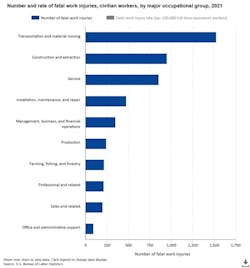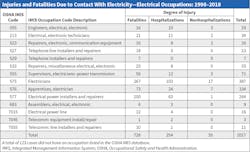New U.S. government data show workplace fatalities in 2021 resumed an uphill climb interrupted in 2020, with construction occupations recording the second highest total among broad classifications.
The 2021 Census of Fatal Occupational Injuries put out by the U.S. Bureau of Labor Statistics (BLS) tallied 5,190 fatal work injuries for the year, almost 9% more than the 4,764 recorded in 2020. That’s a rate of 3.6 fatalities per 100,000 full-time-equivalent workers, the highest rate since 2016.
In the construction and extraction sector, 951 deaths were recorded, down 2.6% from 2020 (Fig. 1). The fatality rate also declined, from 13.5 to 12.3. Among 11 occupations within that sector, electricians had a 7.2 rate, the third lowest. But electrical power line installers and repairers, a subset of installation/maintenance/repair occupations, had a rate of 22 fatalities per 100,000 workers, the 10th highest.
Of the 99 workplace deaths recorded for electrical contractors, 36 were attributed to falls/slips/trips, and 46 were due to “exposure to harmful substances or environments,” a factor linked to 798 workplace deaths overall, a five-year high.
In construction overall, falls/slips/trips accounted for 370 deaths, up 7.2% over 2020, but down from 408 in 2019. In 2021, construction deaths tied to that cause were 65% of the total occupational deaths attributed falls/slips/trips. A total of 850 deaths were caused by that in 2021, with falls to lower levels accounting for the predominant share.
The electricity link
Workplace deaths due to exposure to electricity hit 152 in 2021, up from 126 in 2020 but down from 166 in 2019. While not ranking particularly high on the list of causes of workplace deaths overall, contact with electricity is an ever-present risk in many workplaces — few more persistent and potentially lethal than in electrical contracting, power line work, and construction.
Now, a recently published research paper sheds new light on the vexing problem of managing the exposure of workers in those environments to electrical hazards. Published in the November issue of the Journal of Occupational and Environmental Medicine, “Examination of the Contributing Factors to Fatalities in Electrical Trades Due to Contact With Electricity” distills two decades of Occupational Safety and Health Administration (OSHA) records on workplace deaths due to electricity and concludes that “fatalities in electrical occupations are attributable to increased exposures to electrical hazards during regular work activities, and that strict adherence to safe work practices and procedures is critical to electrical fatality prevention.”
Examining OSHA data from the period 1998-2018, researchers looked at the circumstances surrounding 728 electrical worker deaths and 289 injuries (Fig. 2) tied to contact with electricity – from what jobs they held, when the incidents occurred, the age of the worker to the specific type of injury sustained, the nature of the project, and even the union status of the workplace. That analysis helped the authors determine patterns that could help explain why the incidents occurred, who was most at risk, and gain more insight into how they may have been prevented.
The researchers characterize the typical incident as one in which the victim’s chest, hands for head sustained contact, triggering shock and cardiovascular or respiratory failure. The cause was unsafe conditions arising from deficiencies in facility layout and material handling equipment or method combined with misjudgment of the hazardous situation, improper lockout-tagout procedure and lack of personal protective equipment. The likely environment was a construction project involving either power transmission lines or commercial buildings.
While not coming up with definitive conclusions (but rather encouraging continued study), the paper did highlight the preventable nature of many electrical injuries and fatalities. The primary issue is greater understanding of situational risk and unrelenting diligence in covering all of the hazard-mitigation bases. Lockout/tagout (LOTO) procedures, for instance, get notable callout.
Noting that LOTO procedural malfunction trailed only “misjudgment of the hazardous situation” in many of the studied incidents, researchers said “the prevalence of LOTO issues supports the assertion that working on energized circuits and equipment continues to be a major problem affecting electrical trades.”
Many of the contributing factors, however, have a common denominator: “Unsafe work practices endorsed by management and poor equipment maintenance continue to be the most contributors to electrical trades fatalities.”
Tom Zind is a freelance writer based in Lees Summit, Mo. He can be reached at [email protected].





